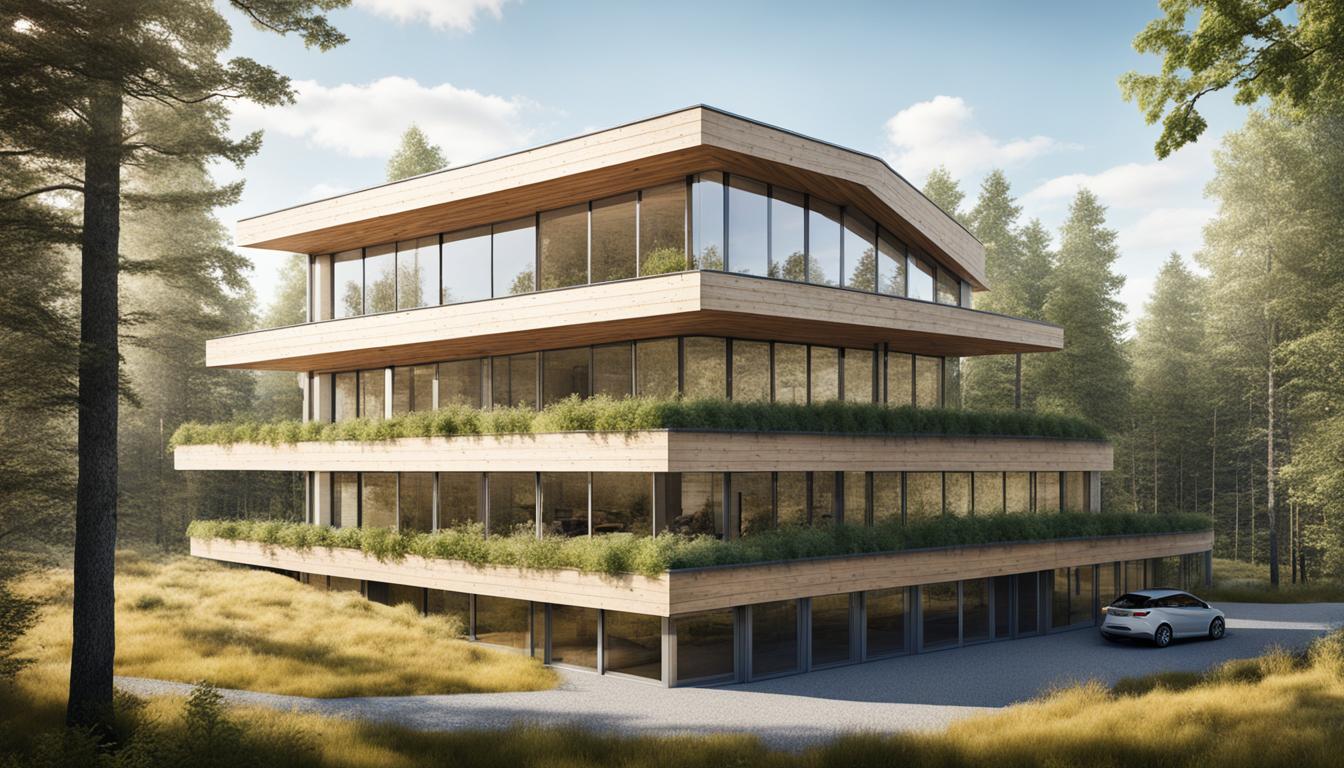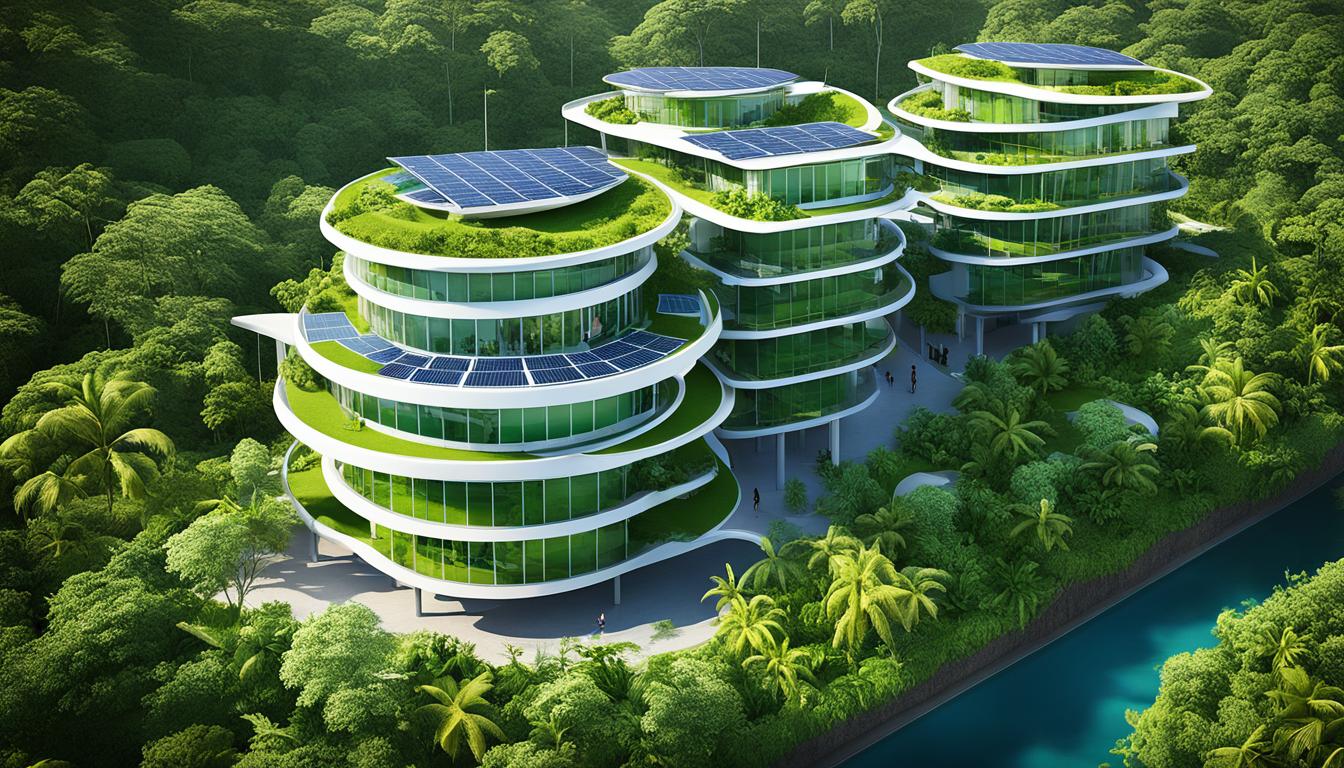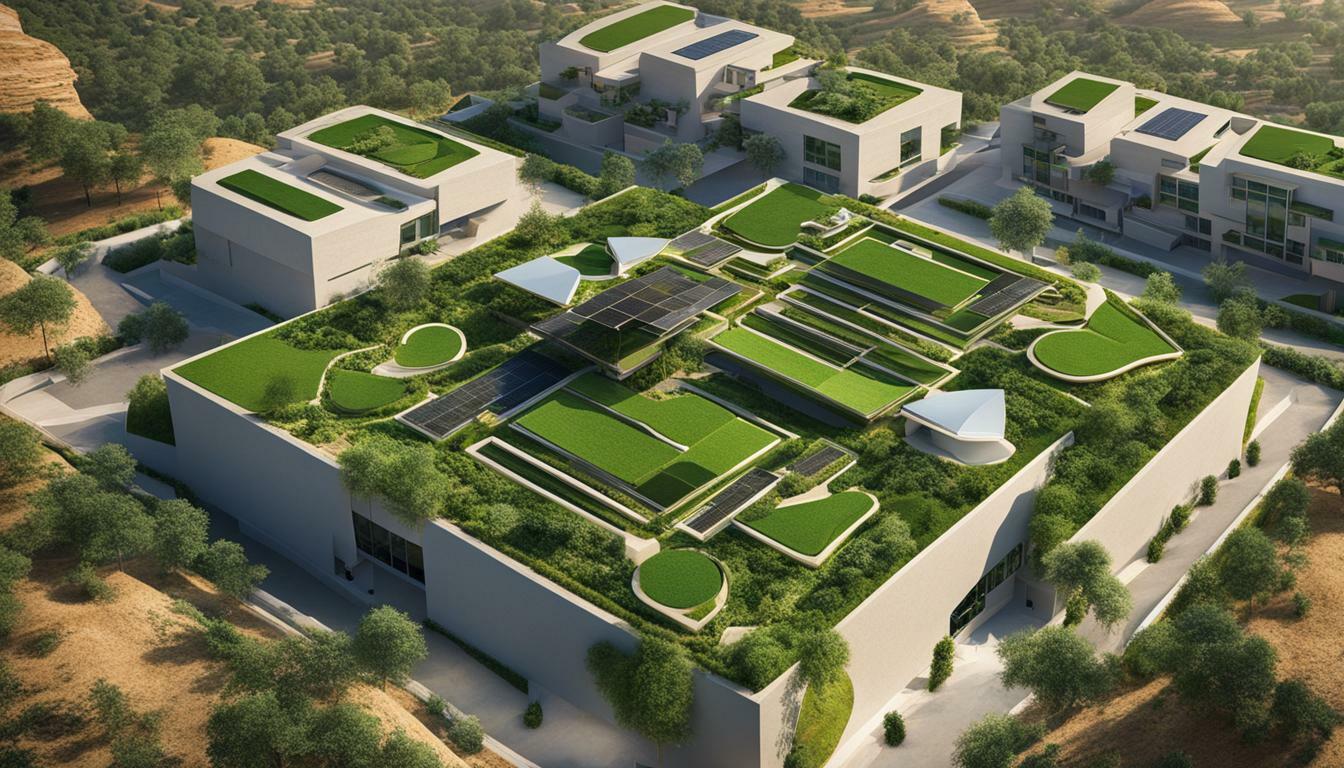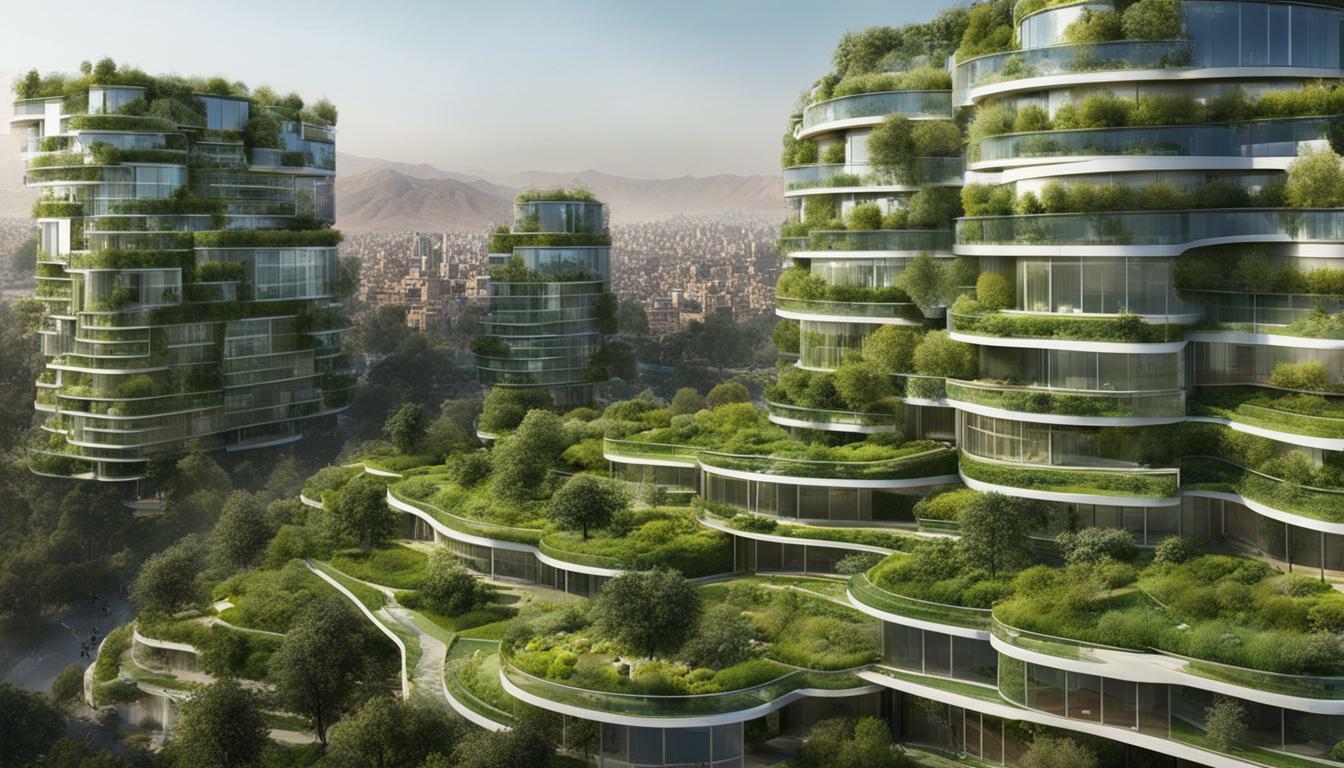Switzerland Top Green Buildings
- Jackie De Burca
- February 13, 2024
Switzerland Top Green Buildings: plus a podcast on zurich
According to Professor Ralph Hansmann, who is a professor in Environmental Social Sciences at ETH Zürich,
“In Switzerland, connection to nature is particularly high. Of course, you have a lot of the urban-rural divide in Switzerland, but the people in the cities have as high environmental attitudes as those in rural areas. Everyone is very connected to nature.”
Therefore, it is built upon a foundation of eco-consciousness, that Switzerland has emerged as a global leader in sustainable architecture and green building design. From energy-efficient structures to environmentally-friendly construction practices, the country is spearheading a sustainable development revolution.
In this article, we will explore some of Switzerland’s top green buildings.
We will also look at some different cities and incorporate other influencing factors, such as how the city is sustainable in other ways.

Photo courtesy of Deposit Photos
Switzerland Top Green Buildings: Zurich
1. Quai Zurich Campus
Serving as the global headquarters for Zurich Insurance Group, this campus is a benchmark in sustainable design. It has achieved both LEED Platinum and WELL Platinum certifications. The campus uses renewable energy sources, including solar panels and lake water for heating and cooling.
Features like green walls, rainwater harvesting, and hybrid workspaces highlight its sustainability focus.

Courtesy of Zurich
2. The Circle at Zurich Airport
This expansive mixed-use development is Switzerland’s largest LEED Platinum-certified project. It also holds the Minergie certification, reflecting high energy efficiency and low environmental impact.
The Circle integrates offices, hotels, retail, and healthcare facilities, all built with sustainability in mind.
The architect of The Circle is Riken Yamamoto.

Courtesy of The Circle
3. Forum Chriesbach
Located in Dübendorf, this building is home to the Swiss Federal Institute of Aquatic Science and Technology (Eawag). It operates without traditional heating or cooling systems, using passive solar design, natural ventilation, and internal heat sources.
A large portion of its electricity is generated onsite via photovoltaic panels.

Courtesy of Forum Chriesbach
4. Prime Tower
One of Zurich’s tallest buildings, Prime Tower holds both LEED Gold and Minergie certifications.
It features high-performance glazing and advanced building systems that reduce energy consumption, demonstrating a strong commitment to energy efficiency.

Courtesy of Prime Tower
5. Greencity Zurich
Situated in the Manegg district, Greencity is Switzerland’s first neighbourhood to receive the “2000-Watt Site” certification. It includes residential, office, and school buildings powered by 100% renewable energy such as geothermal and solar.
Many of its structures meet Minergie-P-ECO and LEED Platinum standards.

Courtesy of Nuesch Development
6. MFO Park
A standout public space in the Oerlikon district, MFO Park is built on a former industrial site and features a steel frame covered in climbing plants.
This living structure provides shade, enhances biodiversity, and improves urban air quality, making it a model of green urban design.

Courtesy of MFO Park
Key Takeaways:
- Switzerland’s green buildings exemplify sustainable architecture at its finest.
- Basel leads the way with its innovative green roof initiative.
- Green buildings contribute to energy efficiency and climate change mitigation.
- Access to green spaces has numerous health benefits for residents.
- Switzerland continues to pave the way for eco-conscious architecture and sustainable development.
- The country’s people play a part in all of this

Get Real Local Knowledge About Zurich’s sustainability: 21-minute podcast episode
In this insightful episode of Constructive Voices, Jackie De Burca sits down with Anna Haas from Neustark to explore the city she calls home—Zurich.
Known for its efficient public transport, green infrastructure, and direct democracy, Zurich has long been a sustainability frontrunner. But how is it maintaining its reputation amid global competition?
Key Topics
Why Zurich dropped from 1st to 24th on the Sustainable Cities Index—and why that’s not necessarily bad news
The 2000-Watt Society goal: how Zurich plans to cut energy use without sacrificing quality of life
Bicycle highways, expensive parking, and the art of nudging behaviour
Pilot boroughs and real-time community feedback
Zurich’s bold CDR (Carbon Dioxide Removal) projects, and what other cities can learn from them
Switzerland’s Top Green Buildings: Basel
Now let’s look at Switzerland’s third biggest city, Basel.
Basel is a pioneer in sustainable urban development and was the first city in the world to mandate green roofs on new and renovated flat-roofed buildings back in 2002. Today, the city boasts over 1 million square metres of vegetated rooftops. We will have a look at those a bit later.
Here’s a look at some of the city’s most impressive green buildings:
HORTUS – Switzerland’s Most Sustainable Office Building
Located in the BaseLink technology campus in Allschwil, HORTUS is designed to be energy-positive—offsetting the energy used in its construction within one generation.
The building features 5,000 m² of photovoltaic panels across its roof and façade, generating surplus renewable energy. HORTUS also emphasises natural materials and flexible workspaces, aligning with the goals of the 2000-Watt Society.
Novartis Pavillon

This innovative structure on the Novartis Campus is both a public exhibition space and an architectural statement in sustainability. The wooden-frame building is wrapped in a façade embedded with 10,000 organic photovoltaic cells and 30,000 LEDs.
These features allow it to operate as a zero-energy building while also serving as a dynamic media surface. Designed by Michele De Lucchi, the pavilion embodies the fusion of technology, design, and environmental consciousness.
Grosspeter Tower

Courtesy of Grosspeter Tower
Completed in 2017, the 78-metre Grosspeter Tower integrates geothermal energy via underground probes and photovoltaic panels on its façade and roof.
These systems provide a significant share of the building’s energy needs.
The tower includes both office space and a hotel, offering a multifunctional model for sustainable high-rise construction.
Roche Tower (Bau 1)

Courtesy of Herzog & De Meuron
As Basel’s tallest building, the Roche Tower showcases how high-rises can be energy efficient. It uses groundwater for cooling and reuses waste heat for heating, outperforming standard Minergie requirements.
With a strong focus on daylighting and flexible office layouts, the tower sets an example for energy-conscious design on a large scale.
City-Wide Green Roof Strategy
Beyond individual buildings, Basel’s green roof ordinance has transformed the cityscape. Since 2002, all new and renovated flat-roofed buildings must include green roofs.
This initiative helps reduce the urban heat island effect, manage stormwater, and increase biodiversity, all while improving building insulation and lifespan.
Basel’s commitment to combining progressive urban policy with sustainable design has made it a standout example in green city planning, proving that even dense urban environments can prioritise nature and long-term resilience.
Green Roofs in Basel: Tackling Energy Wastage and Climate Change
Basel, Switzerland has taken significant steps towards combating energy wastage and addressing the impacts of climate change by implementing green roofs in the city. As part of a forward-thinking law, new and retrofitted buildings with flat roofs are obliged to include green roofs, transforming previously unused spaces into vibrant areas that contribute to urban greening and biodiversity.
The green roofs in Basel serve multiple purposes in the fight against energy wastage and climate change. Firstly, they act as natural insulators, diffusing humidity and cooling buildings more efficiently during the summer months. This reduces the need for excessive air conditioning and ultimately curbs energy wastage. Secondly, green roofs help mitigate the effects of climate change by absorbing carbon dioxide, a major greenhouse gas, and releasing oxygen. By doing so, they contribute to the overall reduction of carbon emissions and assist in creating a more sustainable and resilient built environment.
Furthermore, the presence of green roofs in Basel supports biodiversity conservation in the urban landscape. These roofs provide habitats for insects, birds, and other wildlife, enhancing the overall ecological balance of the city. By promoting urban greening, Basel not only increases the visual appeal of its buildings but also fosters a healthier and more harmonious relationship between humans and the natural world.
The implementation of green roofs in Basel showcases the city’s commitment to sustainable architecture and its proactive approach towards addressing climate change and conserving biodiversity. By turning flat roofs into functional green spaces, Basel sets an example for other cities to follow in their pursuit of a greener and more environmentally conscious future.
Basel’s Green Roofs and Health Benefits
Access to green spaces, such as the green rooftops in Basel, has been shown to have numerous health benefits. Research indicates that spending time in green spaces can reduce the risk of various illnesses, including type II diabetes, cardiovascular disease, and high blood pressure. Green spaces also help mitigate the effects of air pollution and smog, improving overall air quality in urban areas.
Spending time in green spaces can have a positive impact on mental health, reducing stress, anxiety, and depression. The calming effect of nature helps to promote relaxation and improve overall well-being. Whether it’s taking a walk on a green roof or simply enjoying the view, connecting with nature has a rejuvenating effect on the mind and body.
Basel’s green roofs not only contribute to a healthier environment but also enhance the well-being of its residents. By incorporating green spaces into the urban landscape, the city provides a sanctuary for its inhabitants, offering them a place to unwind, reconnect with nature, and reap the many benefits of spending time outdoors.
“The opportunity to escape the concrete jungle and immerse oneself in nature has a profound effect on our well-being. Green roofs in Basel provide residents with a natural oasis in the heart of the city, promoting a healthier and happier community,” says Dr. Anna Müller, a leading researcher in urban health.
Furthermore, green roofs help combat the detrimental effects of air pollution and smog that commonly occur in urban areas. The vegetation on green roofs acts as a natural air filter, trapping harmful pollutants and purifying the air. This can significantly improve the air quality in Basel, reducing the risk of respiratory problems and other related health issues.
Overall, Basel’s green roofs serve as more than just an eco-conscious architectural feature. They provide tangible health benefits, supporting both physical and mental well-being. By incorporating green spaces into the urban environment, Basel is pioneering a sustainable approach to urban development that prioritizes the health and happiness of its residents.
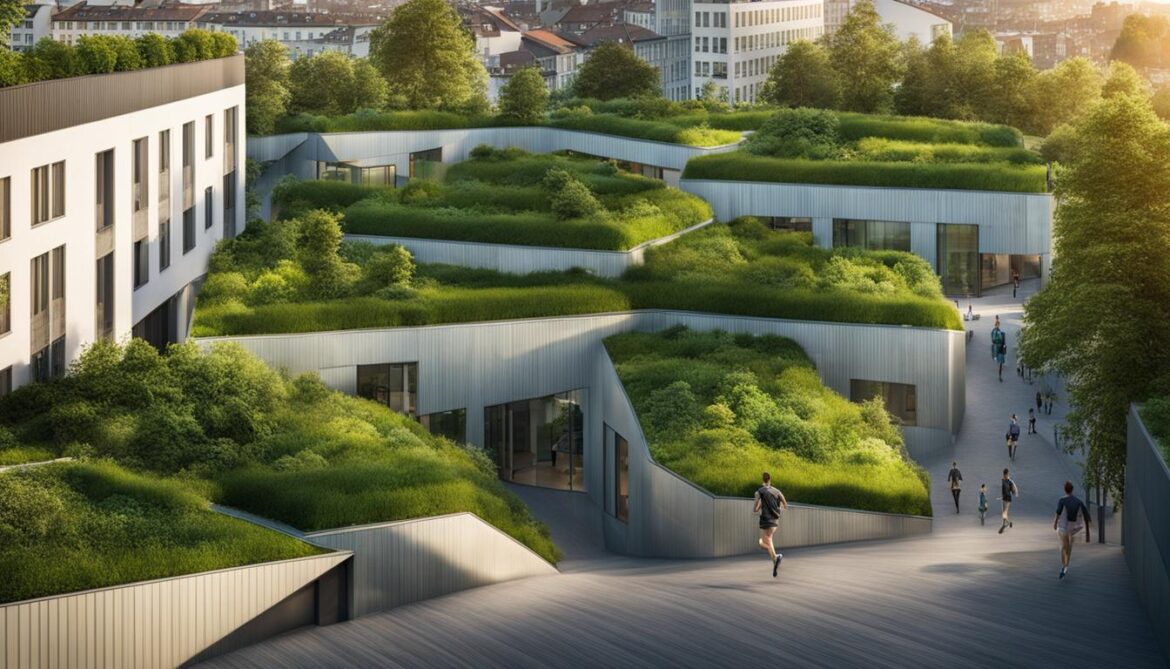
The Olympic House: A Model of Sustainable Construction
The Olympic House, located in Lausanne, Switzerland, serves as the headquarters of the International Olympic Committee. This iconic building stands as a testament to Switzerland’s commitment to sustainable construction and energy efficiency. Designed with the principles of sustainability in mind, the Olympic House has achieved the prestigious Leadership in Energy and Environmental Design (LEED) platinum certificate.
By incorporating various energy-efficient features, the Olympic House showcases Switzerland’s dedication to reducing its carbon footprint and preserving the environment. The building takes advantage of renewable energy sources, such as solar panels and heat pumps powered by the nearby Lake Geneva. These innovative technologies enable the Olympic House to use 35% less energy compared to conventional buildings, setting a new standard for sustainable development.

With its LEED platinum certification, the Olympic House exemplifies Switzerland’s commitment to green building practices. The stringent standards set by the LEED program ensure that the building’s design, construction, and operation prioritize sustainability and energy efficiency. This recognition further solidifies the Olympic House’s status as a top green building in Switzerland and a global leader in sustainable architecture.
“The Olympic House is not only a symbol of the International Olympic Committee’s values but also a shining example of sustainable construction. Its energy-efficient features and LEED platinum certification demonstrate the possibilities of combining sustainability with architectural excellence.” – John Williams, Green Building Expert
Through its advanced design and sustainable infrastructure, the Olympic House serves as a model for future construction projects. It highlights the importance of integrating renewable energy sources and energy-efficient technologies in reducing our environmental impact. This iconic building stands as a beacon of hope and inspiration, inspiring other architects, designers, and developers to prioritize sustainability in their own projects.
The Benefits of the Olympic House’s Sustainable Construction
The sustainable construction of the Olympic House offers a plethora of benefits, both environmentally and economically. Here are some of the key advantages:
- Significant reduction in energy consumption, leading to lower operational costs.
- Decreased reliance on fossil fuels and a decrease in greenhouse gas emissions.
- Enhanced indoor air quality, promoting the health and well-being of occupants.
- Positive impact on the local community and the global fight against climate change.
Switzerland’s commitment to sustainable construction is clearly evident in the Olympic House. This architectural marvel sets a new benchmark for energy efficiency and environmental stewardship. As other countries and organizations strive to build a greener future, they can look to the Olympic House as a source of inspiration and a testament to the power of sustainable design.
Green Roofs as Climate Change Adaptation in Basel
Basel is preparing to tackle the challenges presented by climate change, including projected increases in temperature and changes in precipitation. As part of their proactive approach, the city has embraced green roofs as a vital tool for climate change adaptation.
Green roofs offer multiple benefits in the face of climate change. Firstly, they help reduce surface water runoff, minimizing the risk of flooding during heavy rainfall events. This is especially important in urban areas like Basel, where the risk of flash floods is heightened. By absorbing and retaining rainwater, green roofs act as natural sponges that release water slowly, mitigating the strain on drainage systems.
Furthermore, green roofs are effective in combating the urban heat island effect, which refers to the phenomenon of cities experiencing higher temperatures than surrounding rural areas. The extensive green roofs in Basel help regulate indoor temperatures, reducing the need for energy-intensive cooling systems and lowering associated greenhouse gas emissions. This not only contributes to a more sustainable and environmentally friendly city but also reduces energy costs for building owners and occupants.
Green roofs also act as valuable steppingstones for migratory species, providing patches of habitat in an otherwise densely built-up environment. As climate change disrupts natural habitats, green roofs can help mitigate the effects and support biodiversity. Such green spaces in urban areas contribute to the overall resilience of ecosystems and promote the survival of important species.
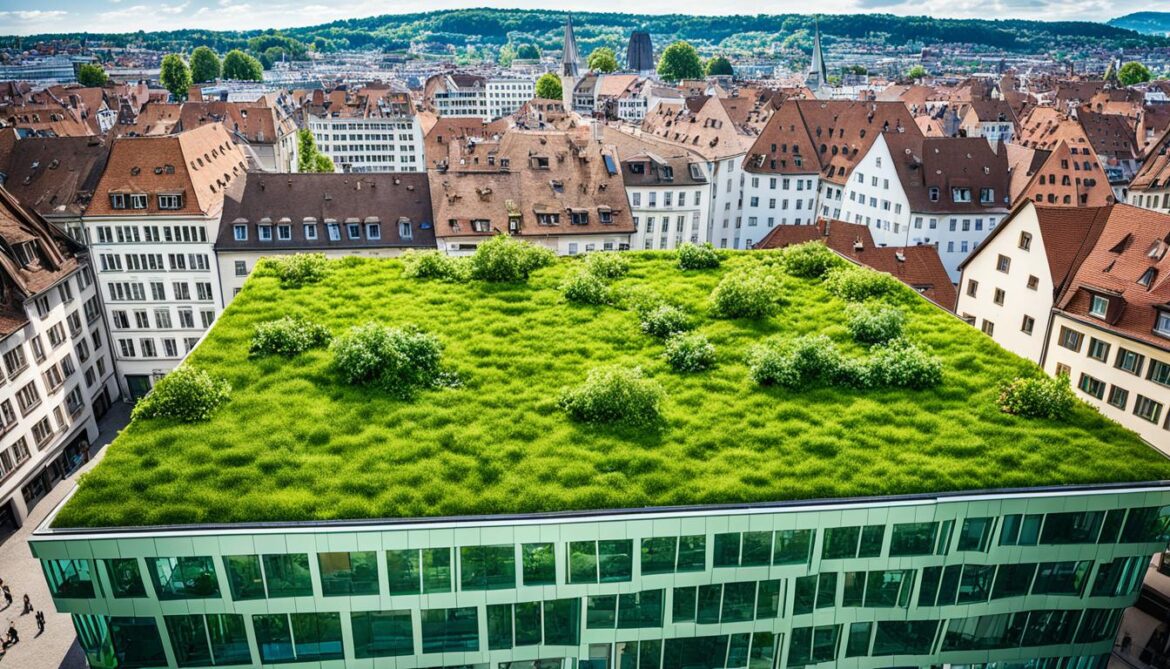
In summary, green roofs play a crucial role in Basel’s climate change adaptation strategy. They reduce surface water runoff, mitigate the urban heat island effect, and provide habitat for migratory species. By embracing green roofs, Basel is safeguarding its urban environment and creating a more climate-resilient city.
The Success of Basel’s Green Roof Initiative
Basel’s green roof initiative has been a resounding success, thanks to the active participation of various stakeholders. Local businesses, horticultural associations, and environmental organizations have come together to drive the implementation of green roofs across the city. Researchers and the community have provided invaluable support, leading to the adoption of financial incentives and building regulations that encourage the integration of green roofs in Basel’s urban landscape.
Over time, the costs associated with green roofs have decreased, making them more accessible and affordable for developers in Basel. They have become a routine feature in the design and construction of new buildings, contributing to the city’s commitment to sustainability. Through careful planning and adherence to specific guidelines, these green roofs are not only environmentally friendly but also incorporate native plant species, ensuring their ecological and fire safety features.
Table: Benefits of Basel’s Green Roof Initiative
| Benefits | Description |
|---|---|
| Energy Efficiency | Green roofs help to regulate indoor temperatures, reducing the need for excessive cooling and associated energy usage. |
| Biodiversity | By incorporating native plant species, green roofs provide habitats for insects and contribute to the preservation of local biodiversity. |
| Stormwater Management | Green roofs decrease surface water runoff, mitigating the risks of flooding and relieving pressure on the city’s drainage systems. |
| Urban Heat Island Mitigation | Green roofs help combat the urban heat island effect, reducing temperatures in densely populated areas and creating a more pleasant living environment. |
| Community Well-being | Access to green spaces provided by green roofs promotes physical and mental health, enhancing the overall well-being of residents. |
The success of Basel’s green roof initiative serves as a model for other cities, showcasing the positive impacts that stakeholder collaboration can bring. By embracing sustainable practices and prioritizing native plant species, Basel has demonstrated its commitment to creating a greener and more resilient urban environment.
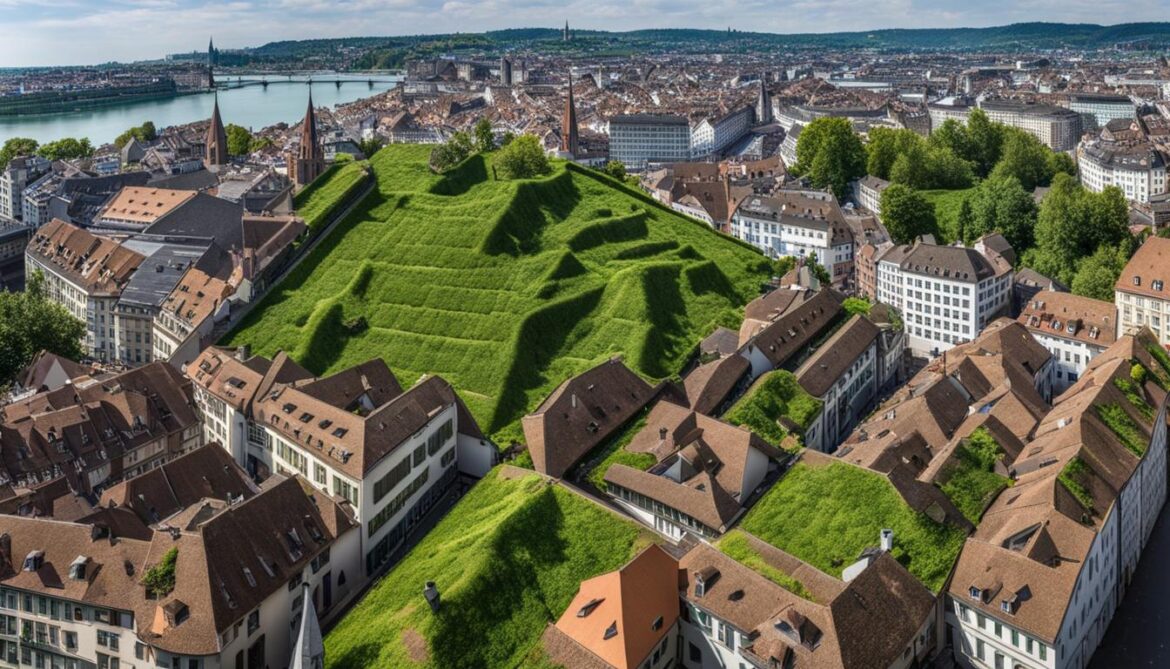
Stakeholder Participation and Collaboration
“Basel’s green roof initiative has been made possible through the collaborative efforts of various stakeholders. The involvement of local businesses, horticultural associations, and environmental organizations has been invaluable in driving the success of this initiative. Together, we have fostered a culture of environmental consciousness and sustainability in the city.”
– Emma Schmidt, Environmental Activist
By embracing green roofs, Basel has made significant strides towards becoming a leader in sustainable architecture and green building design. The ongoing benefits for the environment, economy, and the well-being of its residents make the success of Basel’s green roof initiative a shining example for other cities to follow.
Basel’s Green Roof Regulations
Basel, known for its commitment to sustainable architecture and green building design, has implemented green roof regulations to ensure the proper installation and effectiveness of green roofs in the city. These regulations, first established in 2002 and amended in 2015, provide clear guidelines for building codes, soil thickness, consultation, and insulation membrane requirements.
According to the regulations, the growing medium used for green roofs should consist of native regional soils, promoting the use of natural resources and supporting local ecosystems. The regulations also specify a minimum soil thickness of 12 cm, providing an adequate depth for plant growth and ensuring the longevity of the green roofs.
The roofs are required to include habitat mounds for invertebrates, creating a favorable environment for insects and other small creatures. These mounds contribute to the overall biodiversity of green roofs, supporting the well-being of urban ecosystems.
Additionally, green roof projects exceeding 1,000 m² in size necessitate consultation with the city’s green roof expert during both the design and construction phases. This collaboration ensures that the green roofs meet the necessary standards and align with the vision for sustainable development in Basel.
By enforcing these regulations, Basel demonstrates its dedication to promoting green building practices and environmental sustainability. These guidelines not only contribute to the beauty and functionality of the city’s green roofs but also help mitigate climate change, enhance biodiversity, and create healthier, more vibrant urban spaces.
In summary, Basel’s green roof regulations provide a solid foundation for the implementation of green roofs in the city, setting a standard for other regions to follow. These regulations reflect Basel’s commitment to sustainable development and emphasize the importance of considering nature in every aspect of urban design.

Basel’s Green Roof Regulations Overview
| Regulation | Description |
|---|---|
| Building Codes | Ensure compliance with construction standards and safety regulations. |
| Soil Thickness | Minimum soil thickness of 12 cm to support plant growth. |
| Consultation | Projects over 1,000 m² require consultation with the city’s green roof expert. |
| Insulation Membrane | Incorporation of insulation membrane to enhance energy efficiency. |
Basel’s Green Roof Impact on Biodiversity
Ongoing projects in Basel are studying the impact of green roofs on biodiversity, specifically insects and species composition. Green roofs provide habitats for butterflies, beetles, molluscs, and other invertebrates. These roofs help maintain and enhance urban ecosystems, promoting biodiversity in an otherwise densely built-up area. The results of these studies will further showcase the benefits of green roofs for both climate change adaptation and biodiversity conservation.
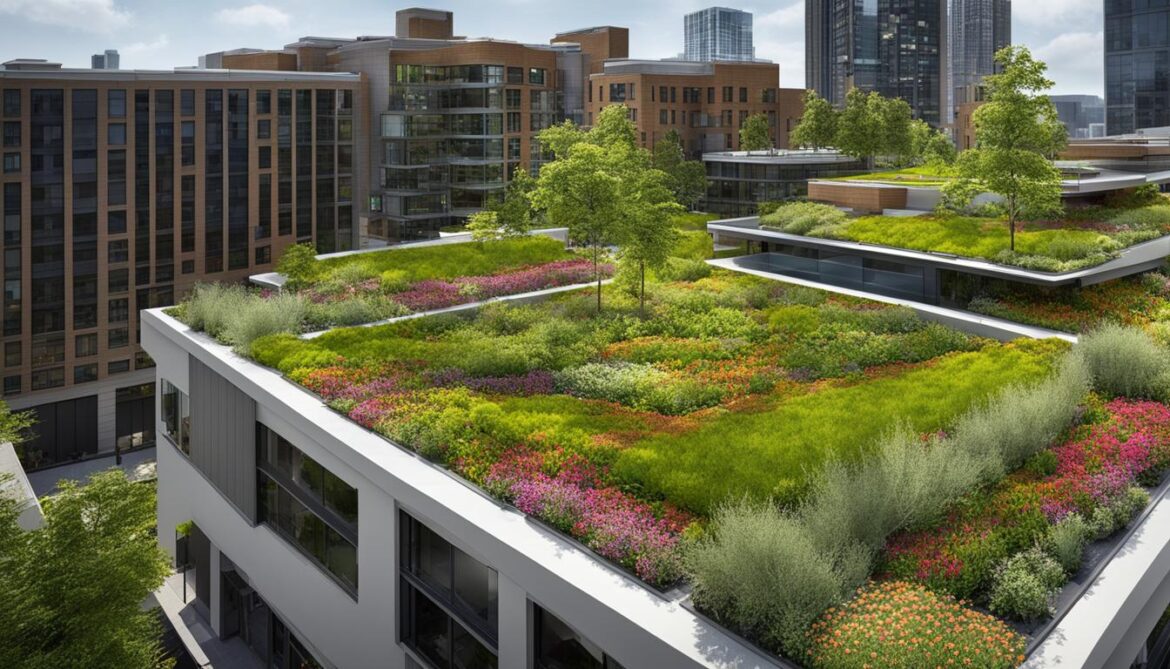
| Insects | Species Composition |
|---|---|
| Butterflies | Provide colorful pollinators that contribute to diverse plant species composition |
| Beetles | Act as decomposers and contribute to nutrient cycling in urban ecosystems |
| Molluscs | Play a vital role in soil health and assist in decomposition processes |
| Invertebrates | Create an interconnected food web, supporting higher trophic levels in the urban ecosystem |
These projects aim to understand how green roofs support various insect populations and influence the overall species composition within urban environments. By providing an alternative habitat to traditional buildings, green roofs offer crucial resources and refuge for biodiversity, contributing to the ecological balance in Basel and beyond.
Future Progress and Outlook
Basel’s green roof system is continuously advancing, with an estimated 40% of the city’s roof surface now covered by green roofs. This impressive progress reflects the city’s commitment to sustainability and eco-conscious development. Ongoing projects are focused on measuring and evaluating the diverse benefits of green roofs, particularly in terms of biodiversity conservation and climate change adaptation.
The results of these innovative projects will be shared and discussed at the Green Roof Congress in 2023. This important event will provide a platform for experts, researchers, and stakeholders to exchange knowledge, insights, and experiences related to green roof technology and implementation. The Green Roof Congress is expected to foster collaboration and inspire further advancements in sustainable construction practices.
Through ongoing projects and the Green Roof Congress, Switzerland’s top green buildings, including those in Basel, will continue to lead the way in creating a more environmentally-friendly and resilient future. The combination of scientific research, stakeholder involvement, and knowledge sharing will drive progress in green roof technology, ensuring their widespread adoption and maximizing their potential to combat climate change.
Ongoing Projects
Let’s take a look at some of the ongoing projects that are contributing to the advancement of green roof technology in Basel:
- A study analyzing the impact of green roofs on local biodiversity, specifically focusing on insect species and their diversity.
- Research exploring the optimal plant compositions for green roofs to enhance biodiversity and support urban ecosystems.
- An evaluation of the effectiveness of green roofs in mitigating the effects of climate change, including temperature regulation and reducing surface water runoff.
These projects play a crucial role in gathering data and insights that will help shape future green roof initiatives and design guidelines. By understanding the specific benefits and challenges posed by green roofs, Basel can further refine its approach to sustainable construction and ensure long-term success.
| Benefits of Ongoing Projects | Significance |
|---|---|
| Enhancing biodiversity and promoting urban ecosystems | Contributing to the preservation of local flora and fauna, protecting ecosystems in urban environments. |
| Improving climate change adaptation | Identifying the effectiveness of green roofs in temperature regulation and reducing surface water runoff, important factors in climate change adaptation. |
| Informing design guidelines | Providing valuable insights that will enable the development of guidelines for optimal plant compositions and sustainable green roof design. |

The ongoing projects in Basel are integral to furthering our understanding of green roofs and their potential benefits. By sharing the findings at the Green Roof Congress, this knowledge can be disseminated and applied not only in Switzerland but also globally, contributing to the future progress of green building design and sustainable urban development.
Conclusion
Switzerland’s commitment to sustainable architecture and eco-conscious construction is evident through the success of Basel’s green roof initiative and the Olympic House in Lausanne. These exemplary projects showcase the country’s leadership in green building design, climate change adaptation, and biodiversity conservation.
Basel’s green rooftops not only contribute to mitigating climate change and adapting to rising temperatures but also offer numerous health benefits to residents. These green spaces promote biodiversity and reduce energy wastage, creating a more sustainable and resilient environment.
With ongoing projects and future advancements, Switzerland continues to push the boundaries of sustainable architecture and green building design. The country’s dedication to creating environmentally-friendly structures sets an example for other nations to follow in the face of climate change and the need for a more sustainable future.
FAQ
What are green roofs?
How do green roofs help reduce energy wastage?
Can green roofs combat rising temperatures caused by climate change?
What are the health benefits of green spaces like green roofs in Basel?
What is the Leadership in Energy and Environmental Design (LEED) platinum certificate?
How does the Olympic House in Lausanne showcase sustainable development?
How do green roofs play a role in climate change adaptation in Basel?
Who has been involved in Basel’s green roof initiative?
What are the regulations for green roofs in Basel?
Do green roofs have an impact on biodiversity?
What is the future outlook for Basel’s green roof system?
Source Links
- https://www.euronews.com/green/2021/07/09/how-this-swiss-city-is-using-green-roofs-to-combat-climate-change
- https://www.euronews.com/green/2019/06/14/olympic-house-switzerland-one-of-worlds-most-sustainable-buildings
- https://climate-adapt.eea.europa.eu/en/metadata/case-studies/green-roofs-in-basel-switzerland-combining-mitigation-and-adaptation-measures-1




